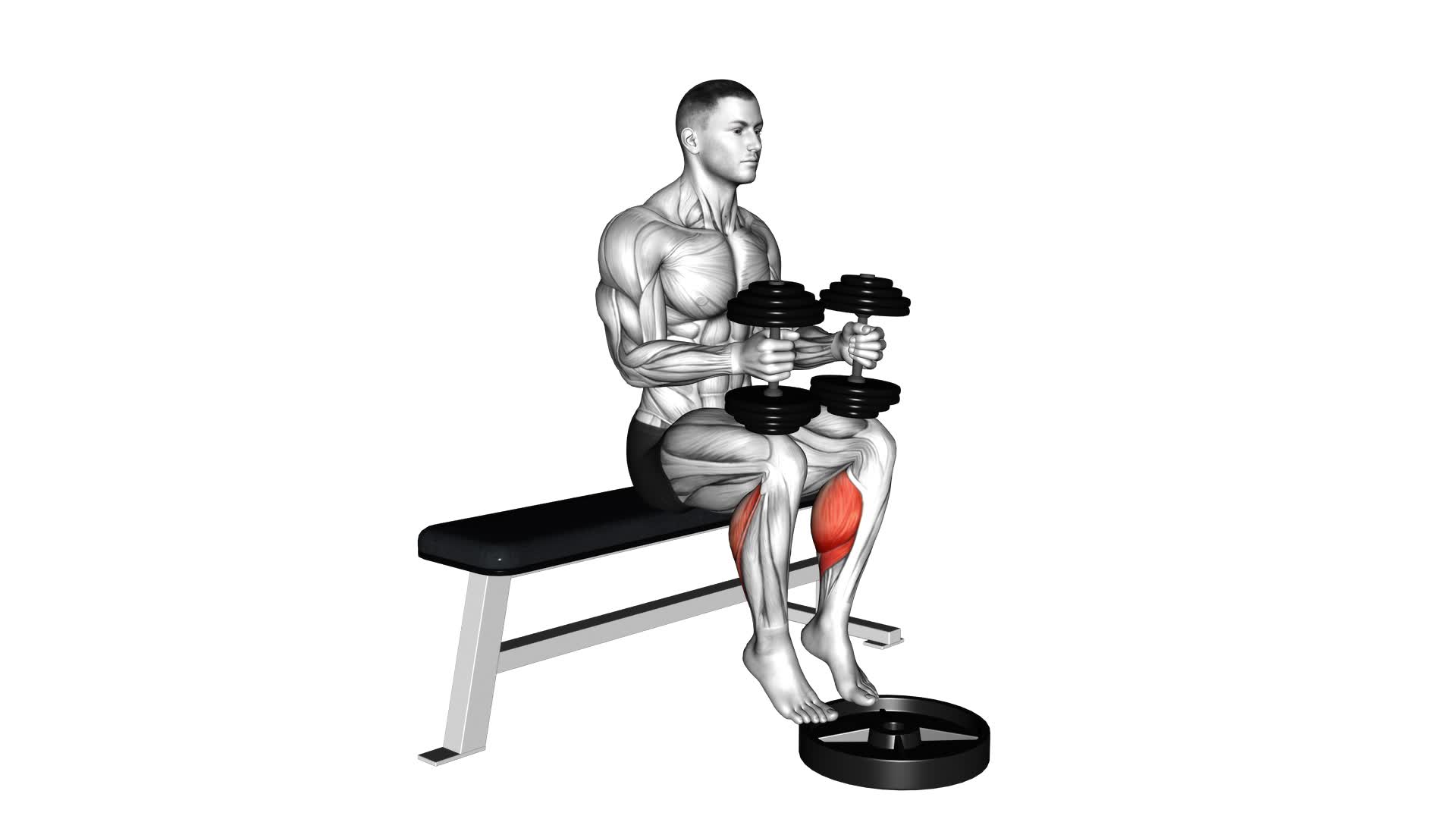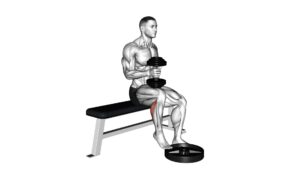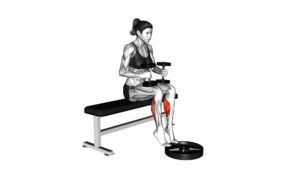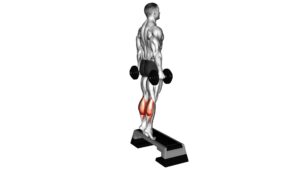Dumbbell Seated Calf Raise – Video Exercise Guide & Tips

Looking to strengthen and sculpt your calf muscles? Look no further than the dumbbell seated calf raise! This exercise targets your calves, helping you build definition and increase overall lower body strength.
Watch This Exercise Video
In this video exercise guide, we'll show you the proper form and technique, tips for choosing the right weight, variations and progressions to keep challenging yourself, common mistakes to avoid, and tips for maximizing your results.
Get ready to take your calf game to the next level!
Key Takeaways
- Targets calf muscles for increased lower body strength and definition
- Engages calf muscles used in everyday activities like walking, running, and jumping
- Provides constant resistance throughout the entire range of motion
- Stimulates muscle growth and promotes balanced calf development
Benefits of Dumbbell Seated Calf Raise
To maximize your calf muscle growth and enhance lower leg strength, the benefits of incorporating dumbbell seated calf raises into your workout routine are numerous. By engaging in this exercise, you're specifically targeting your calf muscles, which play a crucial role in everyday activities like walking, running, and jumping. Dumbbell seated calf raises allow you to isolate and work these muscles effectively, leading to increased strength and size.
One of the key advantages of this exercise is the ability to perform variations that target different areas of the calf muscles. By adjusting the position of your feet, you can target the gastrocnemius (the larger calf muscle) or the soleus (the smaller, deeper muscle). This variety ensures a well-rounded workout and promotes balanced growth throughout your calves.
Furthermore, dumbbell seated calf raises offer the added benefit of providing resistance throughout the entire range of motion. Unlike traditional standing calf raises, where the resistance diminishes as you extend your ankles, the use of dumbbells ensures constant tension on your calf muscles. This continuous resistance stimulates muscle growth and helps you achieve optimal results.
Now that you understand the benefits of incorporating dumbbell seated calf raises, let's move on to the next section, where we'll discuss proper form and technique to ensure maximum effectiveness and safety.
Proper Form and Technique
Continuing from the previous subtopic, let's now focus on executing the dumbbell seated calf raise with proper form and technique. To maximize results and prevent injuries, it's crucial to perform this exercise correctly.
Start by sitting on a bench or chair with your feet flat on the ground and your knees bent at a 90-degree angle. Hold a dumbbell on each knee, ensuring a secure grip. Place the balls of your feet on a raised surface, such as a block or step, with your heels hanging off the edge. This is your starting position.
Next, slowly raise your heels by extending your ankles as high as possible. Hold the peak contraction for a moment before gradually lowering your heels back down to the starting position. It's important to maintain control throughout the entire movement, avoiding any jerking or bouncing motions.
Remember to breathe naturally throughout the exercise and focus on feeling the stretch and contraction in your calf muscles. To prevent injuries, avoid using excessive weight and ensure that your spine remains neutral throughout the movement.
By following these proper form and technique guidelines, you can effectively target your calf muscles and reduce the risk of strains or other injuries.
Choosing the Right Weight
Now let's focus on choosing the right weight for the dumbbell seated calf raise exercise to ensure optimal results and minimize the risk of injury. Selecting the appropriate weight is crucial for targeting the calf muscles effectively and avoiding strain.
Here are some tips to help you with weight selection:
- Start with a conservative weight: Begin with a lighter dumbbell to familiarize yourself with the exercise and ensure proper form. This will also allow you to assess your strength level.
- Gradually increase the load: As you become more comfortable with the exercise, gradually increase the weight. Aim for a load that challenges your calf muscles without sacrificing proper technique.
- Consider your fitness goals: If your goal is to build muscle mass and strength, opt for a heavier weight that allows you to perform 8-12 repetitions with proper form. For endurance and toning, choose a lighter weight and aim for higher repetitions.
- Listen to your body: Pay attention to how your muscles feel during the exercise. If you experience excessive strain or pain, decrease the weight. It's important to find the optimal load that challenges your calves without causing injury.
Variations and Progressions
Now let's talk about the exciting part – variations and progressions!
If you're looking to challenge yourself or take your calf raises to the next level, there are a few options to consider.
You can try different difficulty levels by increasing the weight of the dumbbells or even using a barbell.
Additionally, advanced techniques like adding pauses at the top or bottom of the movement can provide an extra challenge for your calf muscles.
Different Difficulty Levels
To increase the challenge of the dumbbell seated calf raise, you can incorporate variations and progressions. Here are four different difficulty levels to help you further develop your calf muscles and strengthen them effectively:
- Increase the weight: Use heavier dumbbells to add more resistance and intensify the exercise.
- Single-leg variation: Perform the exercise with one leg at a time to increase the demand on your calf muscles.
- Elevated surface: Place a step or block under your toes to increase the range of motion and target different areas of your calf muscles.
- Explosive movements: Incorporate explosive movements by quickly pushing off your toes and lifting the weight as high as possible to engage more muscle fibers.
Advanced Techniques
To further challenge your calf muscles and continue developing strength and definition, incorporate advanced techniques into your dumbbell seated calf raise routine. These advanced modifications and training techniques can take your calf raises to the next level and help you achieve even better results.
One advanced modification you can try is using a heavier dumbbell. Gradually increase the weight as your calf muscles get stronger. This will provide more resistance and help you build more strength and definition in your calves.
Another variation is performing the exercise on an elevated surface. This can be a step or a block. By doing so, you increase the range of motion and engage your calf muscles even more. This variation will intensify the exercise and provide a greater challenge for your calves.
Progressions can also be incorporated into your routine. One way to progress is by doing the exercise with one leg at a time. This will require more stability and balance, as well as isolate and target each calf individually. Another progression is incorporating explosive movements like jump calf raises. This will not only work your calf muscles but also improve your explosiveness and power.
Remember to always maintain proper form and listen to your body to avoid injury while performing these advanced techniques. It's essential to gradually increase the intensity and challenge to prevent overexertion and ensure continued progress. Take your time and gradually incorporate these advanced techniques into your routine, and you'll see even better results in your calf development.
Common Mistakes to Avoid
When performing the dumbbell seated calf raise exercise, be careful to avoid these common mistakes. Proper form is crucial to maximize the effectiveness of this exercise and prevent injuries. Here are four common mistakes to watch out for:
- Using too much weight: It's important to start with a weight that you can comfortably handle. Using excessive weight can lead to poor form and increase the risk of strain or injury.
- Lifting your hips off the seat: Keep your hips firmly planted on the seat throughout the exercise. Lifting your hips can shift the focus from your calves to other muscles and diminish the effectiveness of the exercise.
- Neglecting full range of motion: Make sure to lower your heels as far as possible and raise them as high as you can during each repetition. Avoid rushing through the exercise and focus on achieving a complete range of motion to fully engage your calf muscles.
- Using momentum: Avoid using momentum to lift the weight. Instead, focus on a slow and controlled movement, emphasizing the contraction of your calf muscles. This will ensure that you're effectively targeting the calves and getting the most out of each repetition.
Tips for Maximal Results
To achieve maximal results with the dumbbell seated calf raise, it's crucial to maintain proper form throughout the exercise. This means keeping your back straight, shoulders relaxed, and focusing on contracting your calf muscles.
Additionally, incorporating progressive overload techniques, such as increasing the weight or number of repetitions over time, can help you continually challenge your muscles and stimulate growth.
Proper Form Importance
For maximal results during the dumbbell seated calf raise exercise, it's crucial to maintain proper form throughout. Proper form not only ensures that you target the right muscles but also helps prevent injuries. Here are some tips to help you achieve the best results:
- Common Misconceptions: One common misconception is that you need to use heavy weights to see progress. However, using lighter weights with proper form can be just as effective. Focus on the mind-muscle connection and the quality of your reps.
- Injury Prevention: To prevent injuries, it's important to keep your back straight and your core engaged. Avoid bouncing or jerking motions and maintain a controlled and smooth movement.
- Range of Motion: Aim to fully contract your calves at the top of the movement and allow for a full stretch at the bottom. This will ensure that you engage the muscles fully and maximize the effectiveness of the exercise.
- Gradual Progression: Start with lighter weights and gradually increase the resistance as your strength improves. This will help prevent overloading the muscles and reduce the risk of injury.
Progressive Overload Techniques
To achieve maximal results during the dumbbell seated calf raise exercise, it's important to progressively overload the muscles by gradually increasing the resistance over time. This means challenging your muscles with heavier weights as they become stronger and more accustomed to the exercise.
Progressive overload is crucial for muscle growth and strength gains. However, it's common to hit plateaus where your progress stalls. To overcome plateaus, you can incorporate rest periods into your training routine. Rest periods allow your muscles to recover and adapt, which can lead to renewed progress.
Additionally, incorporating different variations of the seated calf raise, such as using different foot positions or angles, can also help stimulate muscle growth and prevent plateaus.
Frequently Asked Questions
How Many Sets and Reps Should I Do for the Dumbbell Seated Calf Raise?
For the dumbbell seated calf raise, you might be wondering how many sets and reps to do. Well, let's break it down.
The number of sets and reps will depend on your fitness level and goals. Generally, you can start with 3 sets of 12-15 reps.
If you have knee or ankle injuries, make sure to modify the exercise accordingly.
Using dumbbells for seated calf raises offers benefits like improved stability and muscle activation.
Don't forget to incorporate this exercise into your workout routine for strong and sculpted calf muscles.
Can I Do the Dumbbell Seated Calf Raise if I Have Knee or Ankle Injuries?
If you're dealing with knee or ankle injuries, it's important to be cautious when considering the dumbbell seated calf raise. Talk to your doctor or a qualified fitness professional to discuss modifications that can be made to accommodate your injuries.
They may recommend alternative exercises that put less strain on your knees and ankles, such as standing calf raises or using a calf raise machine.
Prioritize your safety and listen to your body's limitations.
Is It Better to Do the Dumbbell Seated Calf Raise With a Barbell Instead of Dumbbells?
When it comes to the dumbbell seated calf raise, you might be wondering if using a barbell is better than dumbbells. Well, let's break it down for you.
Using a barbell for this exercise has its benefits. It allows for a greater load to be used, which can lead to increased muscle growth.
However, using dumbbells can provide more stability and control.
Ultimately, it depends on your preference and fitness goals.
Can I Do the Dumbbell Seated Calf Raise on a Machine Instead of Using Free Weights?
Yes, you can do the dumbbell seated calf raise on a machine instead of using free weights. Using a machine for the seated calf raise offers several benefits.
Firstly, it provides stability and support, reducing the risk of injury.
Additionally, machines often have adjustable resistance, allowing you to gradually increase the intensity of your workout.
Finally, machines can target the calf muscles more effectively, helping you achieve better results.
How Often Should I Incorporate the Dumbbell Seated Calf Raise Into My Workout Routine?
To get the most out of your workout routine, it's important to consider the frequency of incorporating the dumbbell seated calf raise. This exercise can be beneficial for strengthening and sculpting your calf muscles.
Depending on your goals and fitness level, you can include it in your routine 2-3 times a week. Remember to start with lighter weights and gradually increase as you become more comfortable with the movement.
Conclusion
Incorporating the dumbbell seated calf raise into your workout routine can offer a range of benefits. This exercise helps strengthen your calf muscles and improves ankle stability.
To maximize the results of this exercise, it is important to follow proper form and technique. This includes choosing the right weight for your fitness level and avoiding common mistakes.
So grab your dumbbells, get seated, and start working those calves. You'll be on your way to stronger, more defined lower legs.

Author
Years ago, the spark of my life’s passion ignited in my mind the moment I stepped into the local gym for the first time. The inaugural bead of perspiration, the initial endeavor, the very first surge of endorphins, and a sense of pride that washed over me post-workout marked the beginning of my deep-seated interest in strength sports, fitness, and sports nutrition. This very curiosity blossomed rapidly into a profound fascination, propelling me to earn a Master’s degree in Physical Education from the Academy of Physical Education in Krakow, followed by a Sports Manager diploma from the Jagiellonian University. My journey of growth led me to gain more specialized qualifications, such as being a certified personal trainer with a focus on sports dietetics, a lifeguard, and an instructor for wellness and corrective gymnastics. Theoretical knowledge paired seamlessly with practical experience, reinforcing my belief that the transformation of individuals under my guidance was also a reflection of my personal growth. This belief holds true even today. Each day, I strive to push the boundaries and explore new realms. These realms gently elevate me to greater heights. The unique combination of passion for my field and the continuous quest for growth fuels my drive to break new ground.







